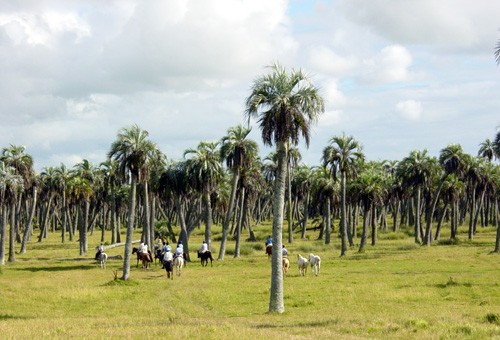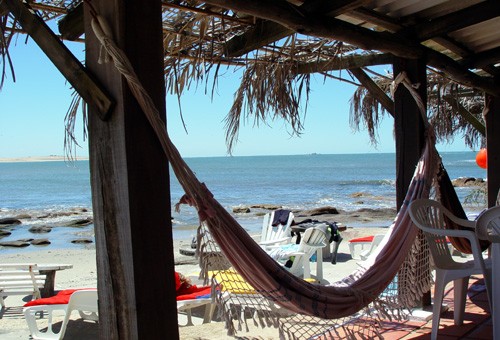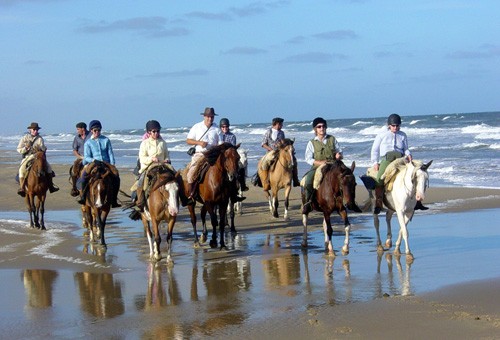Surf and Turf - a special riding adventure in UruguayUruguay - the Unexpected Journey

Jennifer Gordon Smith flies via three different countries to discover Uruguay on horseback, but proclaims it the ride of her life.
“Where’s the nearest pub?” piped up one member of the group, as we approached the first sign of civilization for miles- a remote estancia and our base for the following two nights.
Of course there wasn’t one, but you don’t need pubs on this riding holiday. The sparsely populated, lush green interior is what makes Uruguay a rider’s paradise. It has enormous pastures to canter over, miles of sandy beaches without a sun lounger or overstuffed bikini in sight, and not a whiff of petrol fumes. After that, who has energy for a pub anyway? It was in mid-March that I, and seven other riders, converged in South America to experience this equine utopia.
I knew little about Uruguay beforehand, other than the random trivia that it was the first country to win football’s World Cup- and I had to study an atlas before my eights day adventure (it’s on the east coast, wedged between Brazil and Argentina, for those equally in the dark).
Among our group of eight were a hurley maker (the wooden stick used in the Irish game of hurling) from Tipperary and an orthopaedic surgeon from Limerick who had been riding only a year but had already spent the season hunting with his legendary local pack.
From the USA we had a 69-year-old bionic lady who ran her first marathon at the age of 65, and a Connecticut businessman, plus three high-flyers from London.
The ride began on the Brazilian border, in the beautiful province of Rocha, a four-hour drive from Montevideo, along one of only 10 paved roads in the country. Sally and two gauchos led the way-Martine, who played the “mean and moody” part, and the cheeky-faced Cesar. Both rode what seems to be the regulation gaucho accessory- a fiery chestnut.
Each day we rode for up to eight hours, covering nearly 30 miles. Having ridden sedately for an hour at a time around a London park in preparation, it was a shock to the system, but by day three, and after some medicinal gin and tonics. I had adjusted- with the help of huge sheepskins covering the saddles.
The sturdy native breed of South America is the Crillo. All our horses had fantastic temperaments, sure-footed yet forward-going and responsive enough to turn on a peso. In Uruguay, the horse is still considered primarily a mode of transport, but Sally is introducing British bits and vet treatment and our horses were well cared for. She had done her homework and we were perfectly matched with our respective steeds. Apparently the first canter, with Sally nervously looking on, is the litmus test. Her sense of relief when nobody fell off or revealed they hadn’t learnt to canter yet (which has happened) was visible. I fell in love with Laura, my little roan mare. She was a pleasure to ride and didn’t mind my enormous hugs and pats too much (South Americans don’t do petting).
The tack is minimalist- some bridles consisted of little more than a string headpiece, cheekpieces and bit. Oh, and the girths have no buckles and are tied implausibly far back. But it all seems to work.
I’d never ridden Western before, but as soon as you get the hang of neck-reigning you’re away. To master the lope- the most common pace at which the Uruguayans ride- you slouch your back and sit with your shoulders behind your hips. Unfortunatley, this goes against everything my dressage instructors have drilled into me over the years and after a couple of days bouncing around with my poker-straight back, I reverted to rising trot.

We quickly settled into a daily routine: three- or four- hours riding: picnic or BBQ lunch: siesta: another couple of hours in the saddle in the cool of the late afternoon, and finally a swim, drinks and dinner before bed. We felt very spoilt by having our horses tacked up and waiting for us every morning, getting banquet-proportions of food delivered to picturesque picnic spots and riding to the door of the next night’s accommodation.
As we traveled south along the Uruguayan coast, every day brought different scenery and unexpected sights, all beneath blazing skies. The riding is fast paced, with exhilarating gallops along miles of empty beaches- one of the highlights of the holiday. We passed through huge estancias and weird and wonderful villages, where we received a warm “hola!” from the locals.
We spotted a wealth of wildlife, including birds such as the rhea- a smaller version of the ostrich- storks and owls, Vultures unnerved us slightly as the circled overhead, and we also saw armadillos, one of which may have ended up as road-kill as we galloped (unintentionally) over it.
My favourite day’s ride was heading inland over wetlands, then up through the Don Bosco hills and the 300-year-old palm groves where Aberdeen Angus cattle grazed. We were then treated to lunch next to Laguna Negra (“the black lagoon”) by landowner Fernando. We started with a few tumblers of hooch, a potent alcoholic liquid fermented from palm fruit. The gauchos enjoyed the tradition of passing around a cup of mate (rhymes with latte), which they carry around everywhere in a thermos flask. It is a bitter, green, tea-like liquid drunk through a straw, apparently full of antioxidants as well as a mystery stimulant.
A full rack of wild boar ribs, stuffed beef fresh from the estancia, sausages, wine, salad and vegetables were all consumed as though it was our last supper. We ate extremely well on this holiday.
Our afternoon ride set off slightly later than planned, as our horses made a bid for freedom and sent gauchos running, Benny Hill-style, after them. Safely back on board, we scrambled to the highest point in the area for fabulous views and the regulation photo opportunity.

Beach riding in Uruguay is amazing. One rider described arriving on the huge sandy expanse of Barra Chuy as an “awakening”. As we neared the beach, the sound of crashing Atlantic waves and the scent of salt mixed with pine and aniseed had my senses working overtime. Visitors rarely reach this stretch of sand, so for six mile we walked, cantered, galloped and splashed our way in spending isolation.
Towards the end, we stayed on private estancias. The 12,000- acre Estancia El Sauce was our first sample of traditional living and the brothers who owned it welcomed us heartily. Together with their gauchos, they work the cattle, keep 120 horses and produce a substantial rice crop. Even riding round the estancia for four hours, we didn’t manage to see the whole property. But it provided plenty of opportunities to ‘Vamos!” (“Let’s go!”)- Sally’ cue for us all to up the tempo across the flat grasslands. My new mount was called Gato (“cat”, so called, as he is the traditional Crillo colour of chestnut with a dorsal stripe and tiger-striped legs).
We were led by Carlos, the estancia’s gaucho, and his two sons, both of whom had been allowed the day off school provided they learnt six words of English from us. I don’t think they learnt one, but they certainly taught us a lesson in race-riding, as they left us for dust galloping across the estancia.
Our second ranch stay, Estancia El Charabon, was the ultimate in luxury. It is set in a beautiful location and owned by Jorge and Graciela who, with their exceptional team of staff, went out of their way to spoil us with their hospitality and platefuls of exquisite local food, including slow-roasted pig. Evenings were spent sitting on the terrace watching the sun set, the reverie spoilt only by the incessant scratching of mosquito bites- a real hazard on this holiday. They paled into insignificance, however, when, one night one of the horses was feasted on by a substantially larger bloodsucker- a vampire bat.
On our final day we all donned our cowboy hats and tried our hands at gauchoing. We herded a field of Herefords into a corner and, after being shown how it should be done by the pros, had to peel them off and count them. It soon brought home how skilled these gauchos are. The bulls tended to do their own thing and we didn’t argue.

We were a morose bunch as we rode back to the estancia for the final time and said farewell to our hosts, horses and guides. Some 180 miles and a few bow legs after we’d all set out, broad grins and not forgetting a few thousand photos, it was time to go home. The thrill of galloping across grasslands, beaches and experiencing the Uruguayan rustic lifestyle had us all vowing to join Sally again soon to find out what other equine adventures South America has to offer.
Article first published by Horse and Hound July 2007
What to wear: December to March is summer and days can get hot. Be prepared for the odd downpour, though.
Preparations: some basic Spanish would be useful- we were all frustrated by our inability to converse with the locals.
Group Size: 4-10
Riding Ability: Intermediate to advanced standard is recommended, as you will spend up to 8 hr a day in the saddle with plenty of fast-paced riding.
Contact: Ryan Schmidt at Hidden Trails.
Hidden Trails offers a variety of riding tours all over the world and came across this ride three years ago.
For more info on this trip, check out the Hidden Trails website at
http://hiddentrails.com/tour/uruguay_laguna_negra.aspx
The trip is called: Laguna Negra Estancias Ride
Call Toll Free: 1-888-987-2457 (604-323-1141)
|